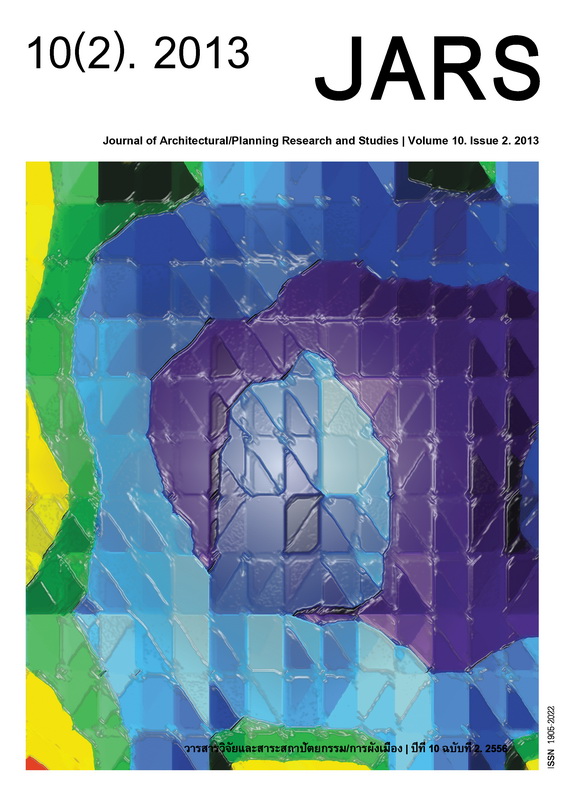The Potential of Agricultural Lands for Conservation of Green Area in Chiang Mai City
Main Article Content
Abstract
Downloads
Article Details

This work is licensed under a Creative Commons Attribution-NonCommercial-NoDerivatives 4.0 International License.
All material is licensed under the terms of the Creative Commons Attribution 4.0 International (CC-BY-NC-ND 4.0) License, unless otherwise stated. As such, authors are free to share, copy, and redistribute the material in any medium or format. The authors must give appropriate credit, provide a link to the license, and indicate if changes were made. The authors may do so in any reasonable manner, but not in any way that suggests the licensor endorses you or your use. The authors may not use the material for commercial purposes. If the authors remix, transform, or build upon the material, they may not distribute the modified material, unless permission is obtained from JARS. Final, accepted versions of the paper may be posted on third party repositories, provided appropriate acknowledgement to the original source is clearly noted.
References
Aphawatcharut, C. D. (2005). เมืองยั่งยืนในเชียงใหม่ แนวคิดและประสบการณ์ของเมืองในหุบเขา [Sustainable cities in Chiang Mai: A case of a city in a valley]. Chiang Mai: Social Research Institute, Chiang Mai University.
Askew, M. (1996). Landscape of the urban fringe: A study of social, physical and economic changes in Nonthaburi province at the regional and local levels. Bangkok: Department of Urban and Regional Planning, Faculty of Architecture, Chulalongkorn University.
Ativitavas, P. & Thongsukplang, S. (2006). การวิเคราะห์ปัจจัยทางกายภาพที่มีอิทธิพลต่อศักยภาพทางพื้นที่ เพื่อรองรับการตั้งถิ่นฐานและการพัฒนาความเป็นเมืองในจังหวัดสมุทรสาคร นครปฐม สมุทรสงคราม เพชรบุรี และอำเภอหัวหิน จังหวัดประจวบคีรีขันธ์ โดยใช้วิธี Potential Surface Analysis (PSA) [Potential Surface Analysis (PSA) for Urban Development in Samutsakorn, Nakornpathom, Samutsongkram, Petchaburi and Huahin, Prajuabkirikhan]. Journal of Architectural/Planning Research and Studies, 4, 37-50.
Bhandhasu, E. & Bejrananda, M. (2011). พฤติกรรมการเดินทางในเมืองหลักของภูมิภาค: กรณีศึกษา เมืองเชียงใหม่ [Travel behavior in regional city: A case study of Chiang Mai city]. Journal of Faculty of Architecture Khon Kaen University, 10, 74-91.
Bunyapravitra, T. (2012). ผังเมืองไทยกับศักยภาพในการยกระดับทางเศรษฐกิจ [Thai urban plan and the economic growth potential]. Retrieved May 12, 2012, from http://asiamuseum.co.th/upload/forum/thaiplan_and_economic.pdf
Ghummaiyer, H. D. (2004). ปัญหา การวางแผนและผังเมืองระดับท้องถิ่นในประเทศไทย: ปัญหา ทางเลือก และความพยายาม [Problems of local urban planning in Thailand : problems, alternatives and attempts]. Retrieved November 22, 2012, from http://www.thaiappraisal.org/thai/monthly/monthly_view.php?strquery=defaultdata.17.htm#manop
Goldberg, M. A. (1974). Residential developer behavior: Some empirical findings. Land Economics, 50(1), 85-89. Land Development Department. (2012). การจำแนกกลุ่มชุดดิน [Soil Classifications]. Retrieved January 15, 2012, from http://www.ldd.go.th/menu_download/download-1.htm
Lee, L. (1979). Factors affecting land use change at the urban-rural fringe. Growth and Change, 10(4), 25-31.
Nathalang, S. (1986). A spatial analysis of factors influencing farmland conversion in the Bangkok metropolitan area, Thailand. USA., Oregon State University.
Prutipinyo, C. (2010).หลักการวิจัยทางสังคม [Principles of social research]. Bangkok: Charoendeemunkong Printing
Rungkawat, N. & Sittisak, P. (2012). การศึกษาการเปลี่ยนแปลงการใช้ที่ดินในเขตเทศบาลเมืองแม่โจ้ อำเภอสันทราย จังหวัดเชียงใหม่ [The study of land use change in Maejo municipality Sansai district, Chiang Mai province]. Thesis (PhD). Chiang Mai, Maejo University.
Thadanjti, S. (1996). The appropriate pattern and management of Bangkok green area. Final seminar: Methodology for implementation of urban planning in Thailand. Bangkok: Chulalongkorn University.
The Treasury Department. (2012). สรุปราคาประเมินทุนทรัพย์ที่ดิน รอบบัญชี ปี พ.ศ. 2555 – 2558 จังหวัดเชียงใหม่ [Summary of estimated land prices during 2012-2015 in Chiang Mai province]. Retrieved March 2, 2012, from http://www.treasury.go.th/internet/land/province_price.htm
Wannasilpa, P. (2012). เทคนิคการวิเคราะห์สำาหรับการวางแผนภาคและเมือง [The technique of analysis for urban and regional planning]. Bangkok: Jarunsanitwongkarnpim.
Yardmak, P. & Anukulyudhathon, E. (2013). ศักยภาพเมืองเชียงใหม่ต่อการเป็นพื้นที่กันชนนอกเขตอนุรักษ์อุทยานแห่งชาติดอยสุเทพ-ปุย [The potential of Chiang Mai city to as a buffer zone outside the protected area of Doi Suthep - Pui national park]. The 49th Kasertsart University annual conference, February 1-4, (pp. 138-147). Bangkok, Thailand.


